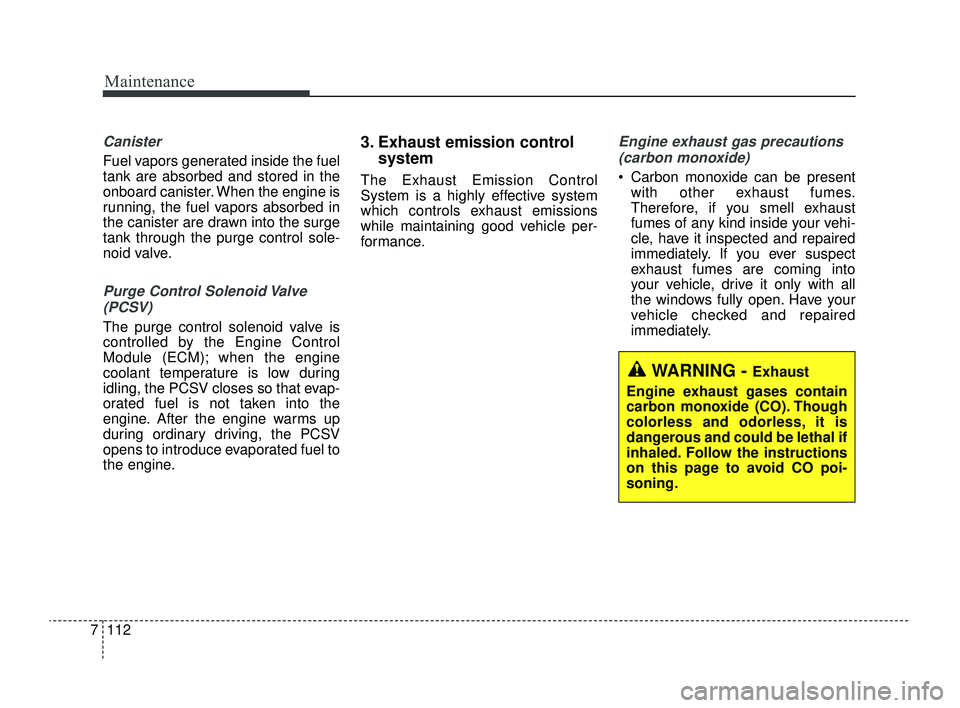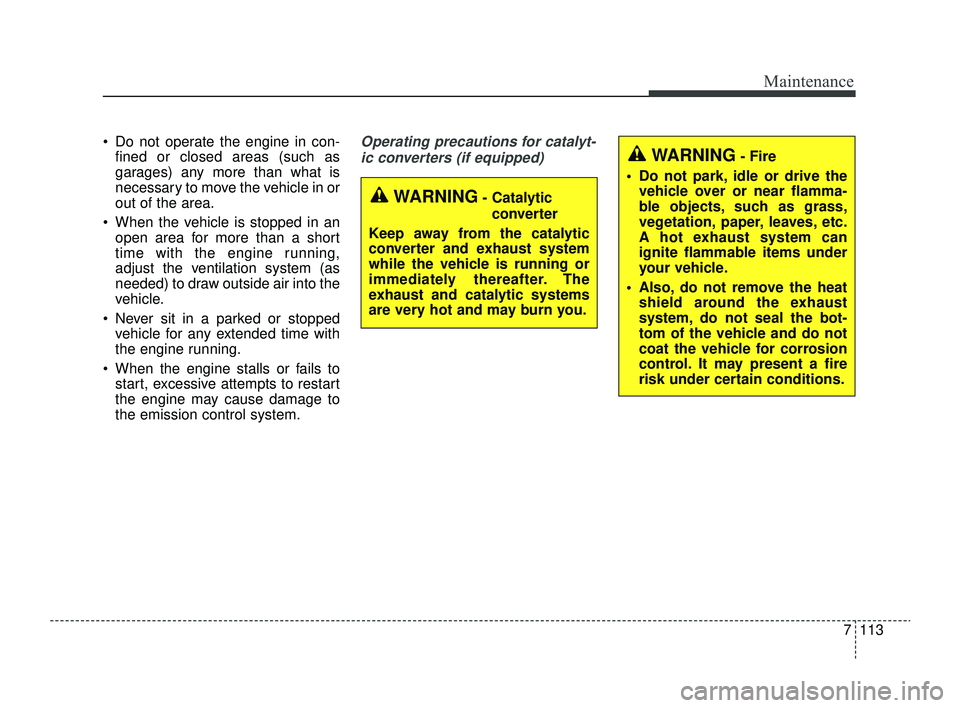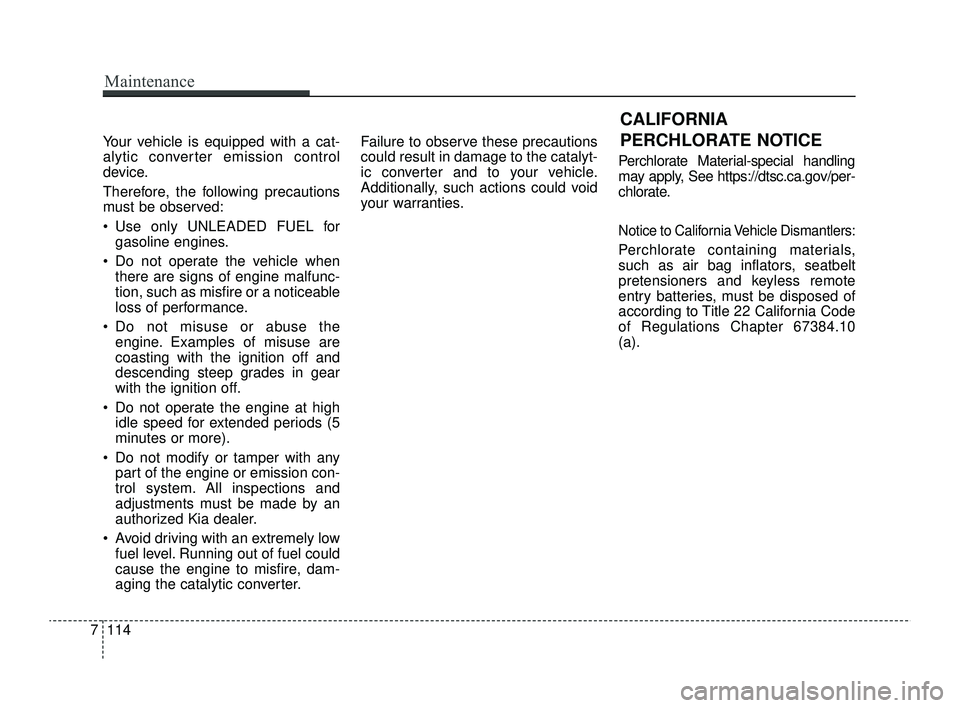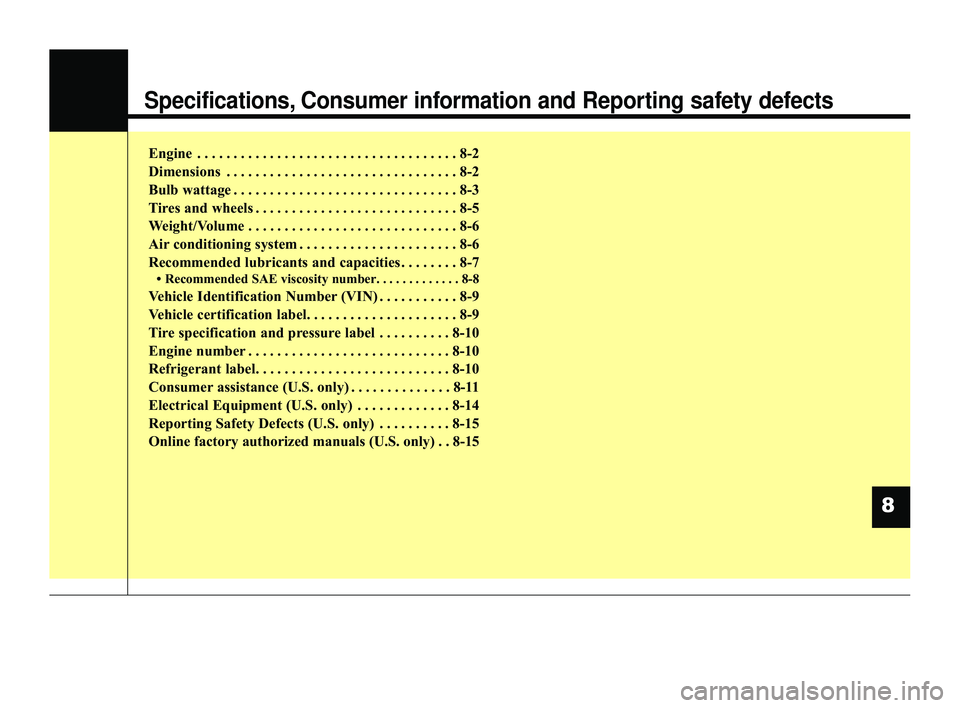Page 499 of 528

Maintenance
112
7
Canister
Fuel vapors generated inside the fuel
tank are absorbed and stored in the
onboard canister. When the engine is
running, the fuel vapors absorbed in
the canister are drawn into the surge
tank through the purge control sole-
noid valve.
Purge Control Solenoid Valve
(PCSV)
The purge control solenoid valve is
controlled by the Engine Control
Module (ECM); when the engine
coolant temperature is low during
idling, the PCSV closes so that evap-
orated fuel is not taken into the
engine. After the engine warms up
during ordinary driving, the PCSV
opens to introduce evaporated fuel to
the engine.
3. Exhaust emission control system
The Exhaust Emission Control
System is a highly effective system
which controls exhaust emissions
while maintaining good vehicle per-
formance.
Engine exhaust gas precautions
(carbon monoxide)
Carbon monoxide can be present with other exhaust fumes.
Therefore, if you smell exhaust
fumes of any kind inside your vehi-
cle, have it inspected and repaired
immediately. If you ever suspect
exhaust fumes are coming into
your vehicle, drive it only with all
the windows fully open. Have your
vehicle checked and repaired
immediately.
WARNING - Exhaust
Engine exhaust gases contain
carbon monoxide (CO). Though
colorless and odorless, it is
dangerous and could be lethal if
inhaled. Follow the instructions
on this page to avoid CO poi-
soning.
SC PE USA 7.qxp 9/9/2021 6:31 PM Page 112
Page 500 of 528

7113
Maintenance
Do not operate the engine in con-fined or closed areas (such as
garages) any more than what is
necessary to move the vehicle in or
out of the area.
When the vehicle is stopped in an open area for more than a short
time with the engine running,
adjust the ventilation system (as
needed) to draw outside air into the
vehicle.
Never sit in a parked or stopped vehicle for any extended time with
the engine running.
When the engine stalls or fails to start, excessive attempts to restart
the engine may cause damage to
the emission control system.Operating precautions for catalyt-
ic converters (if equipped)
WARNING- Catalytic converter
Keep away from the catalytic
converter and exhaust system
while the vehicle is running or
immediately thereafter. The
exhaust and catalytic systems
are very hot and may burn you.
WARNING- Fire
Do not park, idle or drive the vehicle over or near flamma-
ble objects, such as grass,
vegetation, paper, leaves, etc.
A hot exhaust system can
ignite flammable items under
your vehicle.
Also, do not remove the heat shield around the exhaust
system, do not seal the bot-
tom of the vehicle and do not
coat the vehicle for corrosion
control. It may present a fire
risk under certain conditions.
SC PE USA 7.qxp 9/9/2021 6:31 PM Page 113
Page 501 of 528

Your vehicle is equipped with a cat-
alytic converter emission control
device.
Therefore, the following precautions
must be observed:
Use only UNLEADED FUEL forgasoline engines.
Do not operate the vehicle when there are signs of engine malfunc-
tion, such as misfire or a noticeable
loss of performance.
Do not misuse or abuse the engine. Examples of misuse are
coasting with the ignition off and
descending steep grades in gear
with the ignition off.
Do not operate the engine at high idle speed for extended periods (5
minutes or more).
Do not modify or tamper with any part of the engine or emission con-
trol system. All inspections and
adjustments must be made by an
authorized Kia dealer.
Avoid driving with an extremely low fuel level. Running out of fuel could
cause the engine to misfire, dam-
aging the catalytic converter. Failure to observe these precautions
could result in damage to the catalyt-
ic converter and to your vehicle.
Additionally, such actions could void
your warranties.
Perchlorate Material-special handling
may apply, See https://dtsc.ca.gov/per-
chlorate.
Notice to California Vehicle Dismantlers:
Perchlorate containing materials,
such as air bag inflators, seatbelt
pretensioners and keyless remote
entry batteries, must be disposed of
according to Title 22 California Code
of Regulations Chapter 67384.10
(a).
CALIFORNIA
PERCHLORATE NOTICE
7 114
Maintenance
SC PE USA 7.qxp 9/9/2021 6:31 PM Page 114
Page 502 of 528

Specifications, Consumer information and Reporting safety defects
Engine . . . . . . . . . . . . . . . . . . . . . . . . . . . . . . . . . . . . \
8-2
Dimensions . . . . . . . . . . . . . . . . . . . . . . . . . . . . . . . . 8-2
Bulb wattage . . . . . . . . . . . . . . . . . . . . . . . . . . . . . . . 8-3
Tires and wheels . . . . . . . . . . . . . . . . . . . . . . . . . . . . 8-5
Weight/Volume . . . . . . . . . . . . . . . . . . . . . . . . . . . . . 8-6
Air conditioning system . . . . . . . . . . . . . . . . . . . . . . 8-6
Recommended lubricants and capacities . . . . . . . . 8-7
• Recommended SAE viscosity number. . . . . . . . . . . . . 8-8
Vehicle Identification Number (VIN) . . . . . . . . . . . 8-9
Vehicle certification label. . . . . . . . . . . . . . . . . . . . . 8-9
Tire specification and pressure label . . . . . . . . . . 8-10
Engine number . . . . . . . . . . . . . . . . . . . . . . . . . . . . 8-10
Refrigerant label. . . . . . . . . . . . . . . . . . . . . . . . . . . 8-10
Consumer assistance (U.S. only) . . . . . . . . . . . . . . 8-11
Electrical Equipment (U.S. only) . . . . . . . . . . . . . 8-14
Reporting Safety Defects (U.S. only) . . . . . . . . . . 8-15
Online factory authorized manuals (U.S. only) . . 8-15
8
SC PE USA 8.qxp 8/23/2021 5:29 PM Page 1
Page 503 of 528
Specifications, Consumer information, Reporting safety defects
28
ENGINE
ItemSmartstream G1.6
Displacement [cu.in(cc)] 97.09 (1,591)
Bore x Stroke [in(mm)] 2.97 X 3.50 (75.6 X 89.0)
Firing order 1
→ 3 → 4 → 2
No. of cylinders 4, In-line
DIMENSIONS
Itemin (mm)
Overall length
4 Door 172.6 (4,385)
5 Door160 (4,065)
Overall width 67.9 (1,725)
Overall height
4 Door 57.1 (1,450)
5 Door57.1 (1,450)
Front tread
185/65R15 60.0 (1,524)
205/45R1759.5 (1,512)
Rear tread185/65R1560.2 (1,529)
205/45R1759.7 (1,517)
Wheelbase101.6 (2,580)
SC PE USA 8.qxp 8/23/2021 5:29 PM Page 2
Page 504 of 528
83
Specifications, Consumer information, Reporting safety defects
BULB WATTAGE
Light BulbWattage(W)Bulb type
Front Head lamp (Low/High)
Bulb type 55/60W
HB2
LED type LED LED
Front turn signal lamps 21WPY21W
Front position lamps Bulb type
8WPY28/8W
LED type 0.5W x 12 LED
Front fog lamp 51WHB4
Side Marker Lamp Bulb type
5W W5W
LED type 0.5W x 2 LED
Rear Rear Stop/Tail lamps (outside)
Bulb type21W/5W
P21/5W
Rear tail lamps (Inside) 5WW5W
Rear Stop/Tail lamps (outside) LED type1W LED
Rear tail lamps (Inside) 0.2WLED
Side Marker Lamp Bulb type
5W W5W
LED type 0.2W x 3 LED
Rear turn signal lamps 21WPY21W
Back-up lamps 16WW16W
High mounted stop lamp* 5W x 4W5W
License plate lamps 5W x 2W5W
* If equipped(Continued)
SC PE USA 8.qxp 8/23/2021 5:30 PM Page 3
Page 505 of 528
Specifications, Consumer information, Reporting safety defects
48
Light BulbWattageBulb type
Interior Map lamps*
10W x 2W10W
Room lamps 8WFESTOON
Vanity mirror lamps* 8WFESTOON
Glove box lamp* 8WFESTOON
Liftgate room lamp 8WFESTOON
(Continued)
* If equipped
SC PE USA 8.qxp 8/23/2021 5:30 PM Page 4
Page 506 of 528

85
Specifications, Consumer information, Reporting safety defects
TIRES AND WHEELS
CAUTION
When replacing tires, use the same size originally supplied with the vehicle.
Using tires of a different size may damage the related parts or cause them to operate improp\
erly.
*1: Normal load : Up to 3 persons
*
2: If your vehicle is not equipped with a compact spare tire, it will be equipped with a Tire Mobility Kit Item Tire size Wheel size
Inflation pressure kPa (psi)
Wheel lug nut torque
kgf•m (lbfft, Nm)
Normal load *
1Maximum load
Front Rear Front Rear
Full size tire 185/65R15 5.5J X 15
230 (33) 230 (33) 230 (33) 230 (33) 11~13
(79~94, 107~127)
205/45R17 6.5J X 17
Compact spare tire *
2T125/80D15 3.5J x 15 420 (60)
✽ ✽
NOTICE
• We recommend replacing tires with the same make and model originally supplied with the vehicle; no\
t doing so
may affect driving performance.
• When driving in high altitude grades such as mountainous areas, injection of additional air into tires may be required due to lower atmospheric pressure. Therefore, add 1.5 psi for every 1,000m above sea level at the recom-
mended tire pressure when frequently driving in high mountainous areas.
SC PE USA 8.qxp 8/23/2021 5:30 PM Page 5